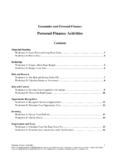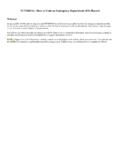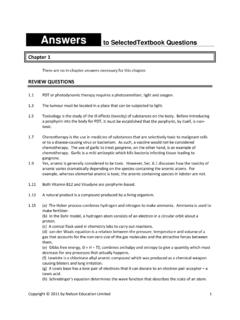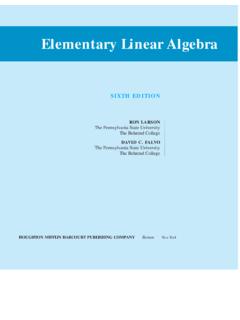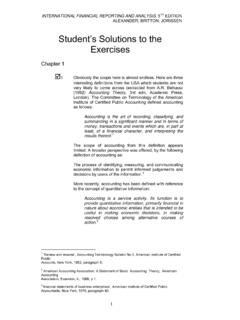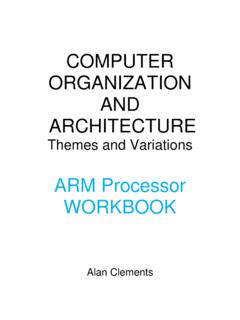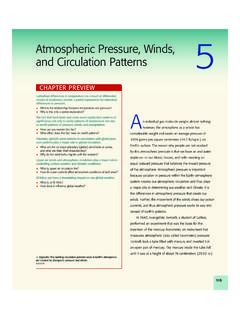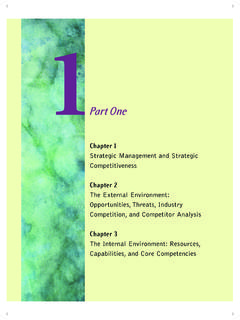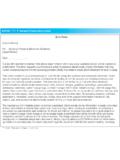Transcription of Introduction to Financial Statement Analysis 7 - …
1 Chapter 1 introduced you to the Financial statements of Great Deal, Inc. As shown in Exhibit , Great Deal earned $1,317 million in fiscal 2012, $1,003 million in fiscal 2011, and $1,407 million in 2010. Exhibit shows that Great Deal s total assets increased over the same period: from $12,758 million in 2010, to $15,826 million in 2011, to $18,302 million in Financial data do not indicate whether Great Deal is performing well or poorly. Specifi-cally, neither the balance sheet alone nor the income Statement alone provides sufficient informa-tion to answer the following questions about Great Deal s performance and risk: How does Great Deal s recent profitability compare to its prior profitability, and to its com-petitors profitability?
2 What is the source of Great Deal s profitability? Does it derive from selling products and services at substantially higher prices than it costs to obtain those products and services? Or does it derive from selling large volumes of products and services? Or from a combination of the two? What risks does Great Deal face? For example, is Great Deal able to pay its debts as they come due?Answering these questions requires Analysis of Great Deal s Financial statements and related information provided in the notes to the Financial statements. This chapter introduces the tools and techniques of Financial Statement Analysis .
3 Figure presents the typical steps in Financial Statement Analysis and OBJECTIVESI ntroduction to Financial Statement AnalysisChapter 71. Understand the relation between the expected return and risk of invest-ment alternatives and the role Financial Statement Analysis plays in providing information about returns and Understand the need to recognize the scale of operations in analyzing perfor-mance. Scale is incorporated by the use of Understand the usefulness of return on equity (ROE) and return on assets (ROA) as measures of profitability, and the relation between these two Understand the insights gained by disaggregating ROE using the DuPont Decomposition Understand the distinction between short-term liquidity risk and long-term liquidity risk and the Financial ratios used to assess Develop skills to compare performance both over-time and (Appendix) Develop skills to prepare pro forma Financial 21910/11/12 2:58 PM10/11/12 2:58 PM220 Chapter 7 Introduction to Financial Statement Analysis1.
4 Understand the purpose and content of three principal Financial statements and related Financial Statement Analysis considers the balance sheet, income Statement , and state-ment of cash flows, discussed in Chapters 4, 5, and 6, Identify the economic characteristics of the industry. We begin by identifying the charac-teristics of the firm s industry. Great Deal is a retailer of consumer electronics, home office products, entertainment software, appliances, and related services. The principal eco-nomic characteristics of this industry are as follows: Nature of products. Great Deal offers products and services that are similar to the offer-ings of its competitors. Common terminology refers to such products as commodities.
5 Extent of competition. The industry is competitive, with many firms offering similar products. Barriers to entry for new competitors include size, distribution network, and market penetration. Growth characteristics. The market is saturated, so further growth must come from introducing new store concepts and expanding Identify the company s strategy. Next, we identify the firm s strategy to compete in its indus-try and gain competitive advantage. Great Deal emphasizes a broad product offering, rela-tively low prices, and superior service. Great Deal also sells through both physical stores and the Calculate and interpret profitability and risk ratios. Most Financial Statement analyses exam-ine ratios that capture either profitability or risk.
6 Ratios based on Financial Statement data provide one analytical tool used to evaluate profitability and risk. This chapter describes and illustrates key profitability and risk ratios. In analyzing a firm s profitability or risk, it is often helpful to compare the firm s performance to a benchmark. Two common benchmarks are the firm s own performance in a prior period (time-series Analysis ), and competitors performance in the same period (cross-sectional Analysis ). We illustrate both types of analyses later in this Prepare pro forma, or projected, Financial statements. After studying the profitability and risk of a firm in the recent past, the analyst often prepares pro forma, or projected, finan-cial statements for the next three to five years, using assumptions about economic, industry, and firm-specific Value the firm.
7 Analysts use projected net income, cash flows, and other items from the Financial statements to value the firm. This textbook does not consider valuation, which is an advanced topic in accounting and OF Financial Statement ANALYSISThe first question the analyst asks in analyzing a set of Financial statements is, What do I look for? The response to this question requires an understanding of investment decisions. To illus-trate, assume that you must decide how to invest a recent gift of $25,000. You narrow the invest-ment decision to purchasing either a certificate of deposit at a local bank or the common stock Understandthe FinancialStatementsIdentifyEconomicChara cteristicsIdentifyCompanyStrategyAnalyze Profitabilityand RiskPreparePro FormaFinancialStatementsValuethe FirmOverview of Financial Statement AnalysisFIGURE 1 Appendix to this chapter illustrates the preparation of pro forma Financial statements for Great Deal for fiscal year 2013 (the year ended February 27, 2014).
8 Cengage Learning 22010/1/12 9:43 AM10/1/12 9:43 AM221 Objectives of Financial Statement Analysisof Great Deal, Inc. Great Deal shares currently sell for $25 per share. You will base your deci-sion on the return you anticipate from each investment and the risk associated with that bank currently pays interest at the rate of 3% annually on certificates of deposit. Because the bank will likely remain in business, you feel confident you will earn 3% each year. The return from investing in Great Deal s common stock has two components. First, you antic-ipate that Great Deal will continue to pay a cash dividend of at least $ per share. Also, the market price of Great Deal s stock will likely change between the time you purchase the shares and the time you sell them in the future.
9 The difference between the eventual selling price and the purchase price, often called price appreciation (or price depreciation, if negative), is the sec-ond component of the return from buying the common stock investment involves more risk (that is, more variability of outcomes) than does the certificate of deposit investment. This is because Great Deal s future profitabil-ity will affect its future dividends and market price changes. If competitors open new stores or introduce new products or services that erode Great Deal s market share, future income might be less than you currently anticipate. On the other hand, if Great Deal opens new stores, or introduces successful new products or services, its future income might be greater than you cur-rently anticipate.
10 Economy-wide factors such as inflation and unemployment will also affect the market price of Great Deal s shares, as will factors such as changes in exchange rates that affect the cost of imported merchandise or government regulatory actions. Because most individu-als prefer less risk to more risk, you will want a higher expected return if you purchase Great Deal s shares than if you invest in a certificate of and empirical research has shown that the expected return from investing in a firm relates, in part, to the expected profitability of the firm. The analyst studies a firm s past earnings to understand its operating performance and to help forecast its future profitability.
